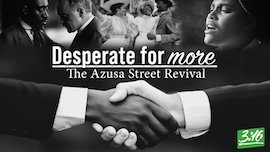Tommy Hicks Astonished ARGENTINA with Hope and Healing
PENTECOSTAL MISSIONARIES first entered Argentina in the early 1900s but had little success winning converts. The largest evangelical churches combined had less than six hundred members in 1949 among all of Argentina’s seventeen million inhabitants. Protestant organizations considered Argentina a fruitless field.
That was the shape of things when 31-year-old R. Edward Miller accepted an assignment in Argentina in 1948. He was to take over a struggling work in Mendoza, where, after seven years of prior effort, the church had only eight members. When his efforts also failed, Miller considered returning home, but instead began to pray for long hours. Two months later, he sensed the Lord telling him to have his small congregation join him for four hours of prayer each evening. A few days later the Holy Spirit fell upon the group. The prayer meeting grew, and for close to a year people would stay until 2:00 or even 4:00 in the morning. The congregation multiplied rapidly and churches throughout Argentina began inviting Miller to speak.
At a small Bible school where Miller taught, a student developed a spirit of prayer. He had an encounter with God that led other students to become filled with awe of God and to loathe their sins. Classes shut down for ten weeks as students and faculty spent ten to twenty hours a day on their knees. Eventually they experienced a joyful assurance that “The Lion of the Tribe of Judah” had prevailed. Students went out in teams of two to preach. Evangelical churches experienced a surge of growth.
In 1954, evangelicals invited Tommy Hicks, an American Pentecostal preacher, to Argentina in place of a better-known evangelist who had declined to go. Hicks abandoned his plans, boarded a plane, and headed south. He asked Christian leaders in Buenos Aires to arrange for a 25,000-seat stadium. The leaders said a venue a tenth that size would suffice. Hicks insisted.
To use a bigger stadium, Hicks needed the permission of Argentina's president, Juan Peron. Many thought it was impossible he would get an interview, but Hicks walked to the Casa Rosada, Argentina’s presidential palace, and asked to see Peron. When he explained his purpose to security members, someone asked Hicks for prayer. After that prayer resulted in a healing, the staff arranged for Hicks to see Peron. On 16 March 1954, Peron granted the stadium and freed evangelicals from restrictions that had held them back. Peron, feuding with the Catholic Church, may have been looking for new allies.
On this day, 14 April 1954, Hicks began preaching in the largely empty Atlanta Fútbol Stadium, but within days, as word of healings and the gospel message got around, the place overflowed. On 22 May, the work moved to the Huracán Stadium, largest in the nation, but the bigger venue also proved too small.
Accounts of Hicks’s interview with Peron and the subsequent events vary widely. What everyone agrees on is that Hicks’s ministry of the gospel and healing attracted enormous crowds and broke Argentina’s resistance to evangelical churches.
As a result, Bible sales and sales of New Testaments soared. At least 100,000 people signed decision cards and an estimated 20,000 people joined evangelical churches. Evangelical growth multiplied steadily thereafter, until the 1980s when it experienced explosive growth under a new generation of home-grown evangelists.
Hicks revisited Argentina in 1955 but was soon expelled from the country. Peron was losing his grip on the nation. Hicks was in car accident in 1958 and had a heart attack the same year. After leading various revival services, mostly in North America, he left ministry in 1966, the year his son, Paul H. Hicks, was ordained in the Assemblies of God. Afterward, Tommy Hicks faded from view. A coworker claimed he became an alcoholic. He died 6 Jan 1973 but the whereabouts of his grave is unknown. His account of the Argentina events, Millions Found Christ: History’s Greatest Recorded Revival, is virtually unobtainable. Seth N. Zielicke researched a careful and non-sensational summary of Hicks’s career in “The Role of American Evangelist Tommy Hicks in the Development of Argentina Pentecostalism.”
—Dan Graves
----------
To learn about the origins of the modern Pentecostal movement of which Hicks was part, watch Desperate for More: The Azusa Street Revival
Other Events on this Day
- Justin Martyr Made a New Theology Based on Greek Philosophy
- MITSUO FUCHIDA, FROM WAR HERO TO EVANGELIST







